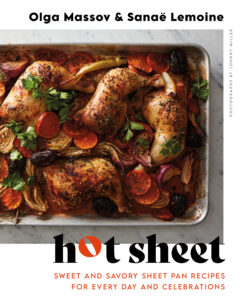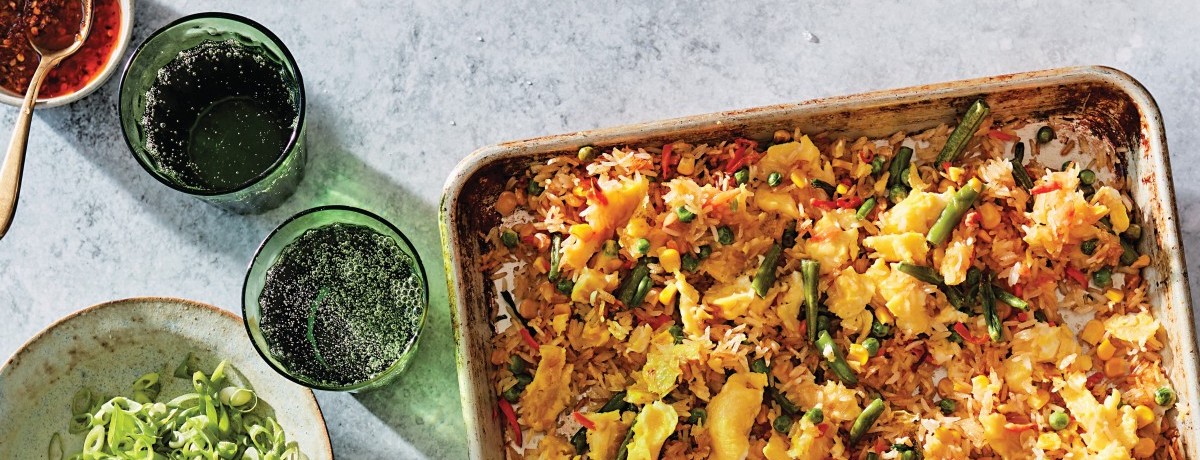I discovered the sheet pan somewhat recently. I was raised on my mother’s Japanese cooking, which requires multiple pots and pans. In our household, we had one or two baking sheets for the occasional batch of cookies, but mostly they languished above the oven.
When I first cooked on a sheet pan in my mid-twenties, I was blown away. I had no idea you could bake entire savory meals on its surface and that it had such an extraordinary range. In fact, I fell so hard and fast that I went through a year of cooking almost exclusively on the sheet pan—fiercely loyal and devoted to this new utensil.
I came across the half-sheet pan in the test kitchen of the meal kit delivery service Marley Spoon (now called Martha Stewart & Marley Spoon) when I was hired as a recipe editor. I had just finished a teaching fellowship, was toiling away on my first novel, and desperate for a full-time job—ideally with a connection to food, my other passion alongside writing fiction.
Although I was raised in a family of talented home cooks, I hadn’t gone to culinary school, so I spent those early weeks in the test kitchen observing, learning, washing every pot and pan that came my way, and hunting down ingredients for photo shoots. I was fortunate to be taken under the wing of two incredible mentors—Jennifer Aaronson and Dawn Perry—who taught me almost everything I know about recipe writing and developing. And most important, they introduced me to the rimmed baking sheet, aka the sheet pan. Their recipes were exceedingly simple but always surprising and often more elegant than an elaborate stovetop meal.
I started to cook on the sheet pan until it became the vessel I turned to most often for its convenience and ease.Alongside Jennifer and Dawn, I started to cook on the sheet pan until it became the vessel I turned to most often for its convenience and ease. I became bolder, experimenting with different flavors, ingredients, and techniques. I learned how to cook several components of a meal on the same sheet pan and how to wilt tender greens using the residual heat from its generous surface.
I was delighted at how perfectly it accommodated one of my favorite baked goods—the sweet or savory galette. (Plus, the rimmed lip caught any leakage from fruit tarts.) I loved its opaque silver surface, a blank canvas for colors and textures. During the photo shoots we showed off how gorgeous the food looked strewn over the sheet pan—along the edges, burnished and crisp; the spacious center, always abundant and inviting.
My appreciation for the sheet pan deepened over the years, until it became a necessity after I moved into an apartment that came with a windowless kitchen and no ventilation. The gas range was wedged against a wall, making half of the burners a pain to access. So, I started using the oven and my sheet pans more than ever, roasting at different temperatures and broiling to achieve a beautiful crust or “sear” without having to smoke up my home.
Olga and I met in 2018 when I was working at Phaidon as a cookbook editor. I started a month after she left, so we had never crossed paths, but I sat at her desk and studied her old files, hoping they might teach me how to be successful in this demanding and often mysterious job. One morning, on a whim, I emailed Olga, introducing myself and asking if she would like to meet. It’s rare for me to contact a stranger out of the blue, and I held my breath, waiting for a response that arrived within the hour. A few days later, we met over pastries at Bien Cuit in Brooklyn, and quickly became the closest of friends.
Our friendship grew through our mutual love of food, for both cooking and eating. While our styles of cooking are different, as are our backgrounds, we noticed a rare chemistry in our conversations about food. We could talk about recipes on end, exchanging ideas, building off each other’s questions, expanding our understanding of an ingredient or dish. It was always exhilarating, the hours going by in the blink of an eye.
So often, mid-conversation, we’d experience that aha moment of “This is exactly what the recipe needs, I must try this now, why didn’t I think of it myself?!” We cooked each other’s recipes from a distance (I live in Brooklyn, Olga in Silver Spring, just outside of DC), and over the years, our appreciation for each other only deepened. When Olga asked me if I’d like to write a cookbook together, I couldn’t believe my luck. The answer was obvious—bien sûr (of course)!
–Sanaë Lemoine
*

Sheet Pan “Fried” Rice
Serves 4 to 6
For the rice:
2 tablespoons neutral oil, such as canola or grapeseed
11/2 tablespoons Chinese light soy sauce
3/4 teaspoon toasted sesame oil
1/2 teaspoon kosher salt
4 to 5 generous cups (680 to 850 g) leftover cooked rice
One 16-ounce (454 g) bag frozen mixed vegetables (no need to thaw)
3 large eggs, lightly beaten
For the sauce:
2 tablespoons dark soy sauce
1 to 2 tablespoons honey, to taste
1 to 2 teaspoons Chinkiang vinegar, to taste
1 teaspoon grated fresh ginger
For serving:
Thinly sliced scallions (optional)
Furikake (optional) Chili crisp (optional)
Consider this recipe one that checks all the boxes on winning the weeknight dinner lottery: Fast, flavorful, and customizable. And while it’s technically not fried rice, it’s a hands-off method for making lots of crispy rice at once. Normally, I cobble together bits and bobs of frozen vegetables from my freezer, but if you don’t have an assortment to choose from, the premixed bag of carrots, corn, peas, green beans, and lima beans comes to the rescue. But perhaps the most winning quality of this dish is the amount of audibly crispy bits that it produces.
–Olga Massov
Make the rice: Position a rack in the middle of the oven, place a half-sheet pan on it, and preheat to 450°F (230°C).
In a large bowl, whisk together the neutral oil, light soy sauce, sesame oil, and salt. Add the rice and toss to combine. The rice should be evenly coated in the oil but will have some darker clumps where the soy sauce penetrated and white clumps where it didn’t—that’s okay. Remove the hot sheet from the oven, set on a heatproof surface, and, carefully transfer the rice mixture to it. Spread out in an even layer and return to the oven. Roast for 15 minutes, or until the rice starts to crisp up and turn light golden.
Remove the pan from the oven, add the frozen vegetables, and carefully—the pan will be searing hot—stir to distribute. Return to the oven for another 15 minutes, or until the rice is rich golden brown and the vegetables are tender.
Remove the pan from the oven and push the rice and vegetables out to the sides, creating an empty space in the center. Pour the eggs in the space and return the sheet pan to the oven for 2 to 3 minutes, or until the eggs are cooked through and opaque. Remove from the oven and break up the egg, stirring it into the rice and vegetables.
Make the sauce: While the rice and vegetables are roasting, in a small bowl, whisk together the dark soy sauce, honey, vinegar, and ginger until combined. Taste and adjust the sweetness and/or acidity to your liking, if needed.
To serve: Divide among shallow bowls and drizzle with the sauce. Top with scallions, furikake, and chili crisp, if you like.
__________________________________

From Hot Sheet: Sweet and Savory Sheet Pan Recipes for Every Day and Celebrations by Olga Massov and Sanaë Lemoine. Copyright © 2024 by Olga Massov and Sanaë Lemoine. Reprinted by permission of Harvest, an imprint of HarperCollins Publishers.



